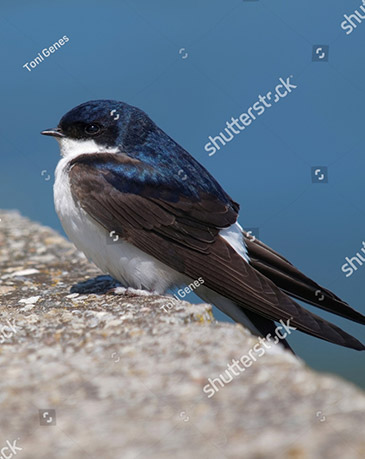Common House martin (Delichon urbicum)
Common House Martin is found throughout the European continent, from the southern Mediterranean countries to the far north of Scandinavia, as a summer breeding species.
In our country it is a summer visitor (March-October) while individuals may appear earlier (mid-February).


Identification
- Body length 13.5-15 cm.
- Wingspan: 26-29 cm.
- Easily identified by the white-white uropygium that contrasts sharply with the otherwise black upperparts that gleam a dark blue hue on the crown, mantle and "shoulders".
- Short black tail moderately scissored without long outer tail feathers.
- Legs covered in white feathers which is evident when sitting on the ground to gather mud.
It is a chatty bird with a sweet and enthusiastic chirp.
Sample Voice:
https://www.xeno-canto.org/species/Delichon-urbicum
The flight of the house martin is more irregular and slower than the flight of the barn swallow.
It usually flies slowly and in a curved trajectory with frequent aerial glides with outstretched wings.
During migration it often roosts in groups in trees (not in reeds).
Once the young fly they often sit many together on wires.
Hunts insects at various heights, but usually high (much higher than the barn swallow).
Nesting
Forms colonies at cities and villages, but also on rocks and open areas where it breeds.
It builds its closed nest from mud on the top of walls, under balconies on bridges, etc., without showing any particular fear of human presence. They often build nests under eaves and other artificial structures, usually in large colonies. They use the outside of buildings instead of the inside, unlike the barn swallow which uses the inside of barns or stables.
The nest is a uniform nest, constructed by both sexes with mud pellets reinforced with plant fibers, and there is only a small opening for the birds to get in and out of the nest.
When nesting in natural habitats they build their nests in crags and cliffs.


It lays twice a year, from April to September, 4-5 eggs each time.
After the births, the nest is repaired for the following years.
It is a sympatric and beneficial bird (it feeds on flying insects) for humans. Nuisance can be caused by the accumulation of droppings under the nests which may lead some to destroy or remove the nests from their homes.
House martin is included in the species listed in Appendix II of the Bern Convention on the Conservation of European Wildlife and Natural Habitats.

